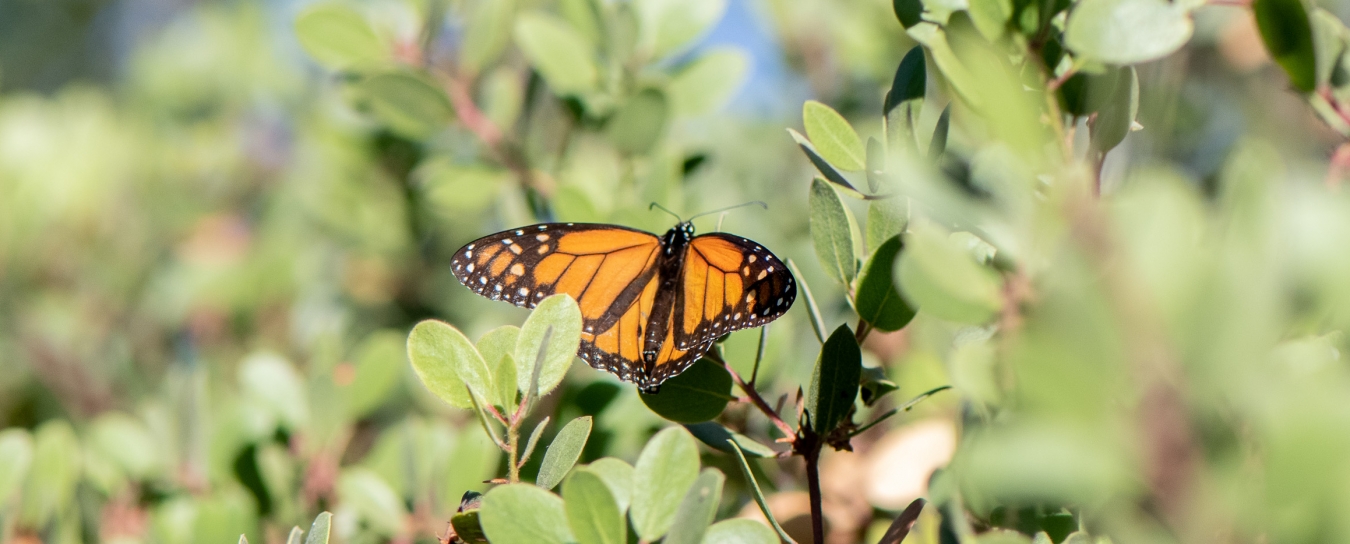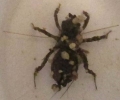
Invertebrates
See our handy guide to critters found in local homes and our Central Coast Butterfly FAQ. Browse the insects and other terrestrial arthropods we’ve identified. Check out local marine invertebrates, particularly bivalve mollusks and intertidal organisms.
- Anthropology
- Rocks & Fossils
- Invertebrates
- Vertebrates
- Botany
- Astronomy
- Fungi
- General
- Recently Asked
Mystery insects
I am hoping you can help me with a TON of very strange insects that have shown up in our 50 gallon horse trough. In cleaning the bottom I scooped up about 50 of them along with the sludge. We have had horses for 40 years and never had these! The trough was emptied completely and bleached about a month and a half ago. So these have come since then.
I put the specimen that is in the photo in a plastic bag 3 days ago and it is still alive. So, they obviously can survive under water and on land. They are a little less than ½ inch long. The “beads” you see on this one are pieces of sand from when I dumped them out into the sand paddock. I am SURE that there are many more left in the water trough. I am waiting to find out what they are, where they came from and how to keep from getting them again before I pour Clorox in the trough to kill them.
The only new thing I have added to the trough is a “bale” of barley straw sold for ponds to keep the algae at bay; added about a month ago. I am wondering if this had eggs from this insect that hatched when they got wet.
I hope this photo is good enough. If not, let me know and I can dredge up another of these insects and maybe get a better shot.
Would these pose a danger to our horse, or the mosquito fish we keep in the trough? Are they here to stay?
Thank you so much for your help!

Curator Response
Hi Cynthia,
What you have are immature dragonflies! This stage, called a nymph or naiad, is equivalent to a larva of other types of insects. The nymphs of dragonflies are aquatic and quite different-looking from the adult; however, like the adult dragonfly, the nymph is a fierce predator, and has long, lightning-fast, extensible prey-grabbing jaws folded up underneath its head!
That said, they shouldn’t pose a danger do your horse. These will mostly stick to the sludge on the bottom and opportunistically feed on aquatic insects and crustaceans. As for eating mosquitofish, they would certainly take the opportunity to eat some if they had the chance! Yet I would be very surprised if they had a negative effect on the fish population. Since mosquitofish tend to stay near the top of the water column (I think), and dragonfly nymphs tend to be on the bottom, close encounters might be rare. Fishes are also pretty agile, so it would have to be a lucky attack for a dragonfly to nab one. The good news is that even if they do, the dragonfly nymphs will also eat mosquito larvae, and adult dragonflies eat adult mosquitoes! So you’re actually doubling up on your mosquito control by adding immature dragonflies to your trough ecosystem.
It's extremely difficult to precisely identify these dusky critters to species from a photo alone, but based on body shape, the one you shared with us is probably in the family Libellulidae (the skimmer dragonflies). This makes sense biologically, since these dragonflies tend to be tolerant of a wide range of habitats (including low-oxygen water like water standing in a trough) and many of them grow and develop very rapidly. There are nearly 40 species of skimmer dragonflies native to California, and around 22 known from Santa Barbara County alone.
I don't know how the bales of barley straw are manufactured and treated, but it seems unlikely that the dragonfly eggs or nymphs were brought in through that route. However, we’re talking about animals that often accidentally lay their eggs on car hoods (they mistake the polarized light reflection for the water surface), so at least certain species are really not that choosy about selecting habitats, just as long as it looks to them like a decent-sized pool of water. Skimmer dragonflies typically deposit their eggs directly into water, and almost certainly one or more females laid their eggs directly into your horse trough.
Here's a nice bonus fact for you: dragonfly nymphs are also able to jet for short distances by rapidly pumping water through their rectum! Spectacular animals.
Thanks for sharing these with us!
Stay curious,
Schlinger Chair and Curator of Entomology Matthew L. Gimmel, Ph.D.

